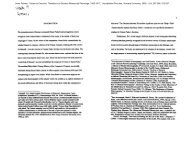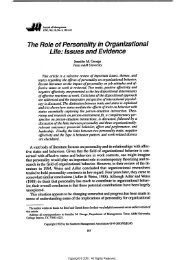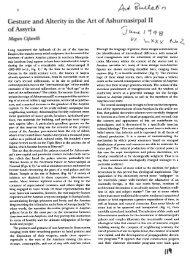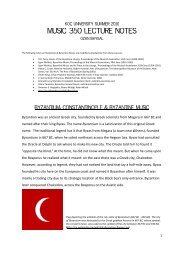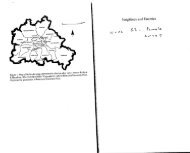The Hattian and Hittite Civilizations
The Hattian and Hittite Civilizations
The Hattian and Hittite Civilizations
Create successful ePaper yourself
Turn your PDF publications into a flip-book with our unique Google optimized e-Paper software.
Fig. Illa, b Reliefs from Carchemish. Museum of Anatolian <strong>Civilizations</strong>, Ankara.<br />
<strong>The</strong> <strong>Hittite</strong> Traditional Style continues in the second half of the 8th century BC<br />
Fig. 112 <strong>The</strong> head of one of the lions at the city gate. Malatya, Aslantepe. 1050- 850 Be. Museum<br />
of Anatolian <strong>Civilizations</strong>, Ankara.<br />
Early Traditional Style.<br />
Fig. 113 Statue base with lions. Carchemish. Second half of the 8th century BC. Museuırı ()f<br />
Anatolian <strong>Civilizations</strong>, Ankara.<br />
<strong>The</strong> base with lions is from the Traditional Style IL<br />
Fig. 114a, b One of the lions from the inner gate of the city's outer wall at Zincirli. 832 - 810 BC.<br />
<strong>The</strong> <strong>Hittite</strong> Traditional Style under Aramaean influence.<br />
Fig. 115 One of the two lions from gate Q at Zincirli. 832 - 810 BC.<br />
<strong>The</strong> <strong>Hittite</strong> TraditionalStyle under Aramaean influence.<br />
Fig. 116 Zincirli. Relief from the outer city wall of Zincirli. 832 - 810 BC.<br />
<strong>Hittite</strong> TraditionalStyle under Aramaean influence.<br />
Fig. II 7 War chariot. Zincirli. 832 - 810 Be. Museum of the Ancient Orient, IstanbuL.<br />
Traditional Style showing Aramaean <strong>and</strong> Assyrian influences.<br />
Fig.118 <strong>The</strong> Aramaean King Kilamuwas. Zincirli. (832 - 810 BC). Berlin Museum.<br />
Kilamuwas <strong>and</strong> his son behind him are executed in the Assyro-Aramaean style.<br />
my god is Baal, Harran". Barrekub was king around 730 C. Before him his scribe st<strong>and</strong>s at<br />
attention. <strong>The</strong> noses of both are of the curved Semitic type. On his head he wears a type of<br />
tiara particular to the Aramaeans. His hair <strong>and</strong> beard are in the Assyrian fashion, he even has<br />
a mustache, contrary to <strong>Hittite</strong> tradition. <strong>The</strong> lock of hair that falls in front of his ear is an<br />
Aramaean - Phoenician element. <strong>The</strong> throne upon which he sits is worked according to<br />
Assyrian examples. <strong>The</strong> folds of his garment wi1llater pass to Hellene art by various routes.<br />
in this relief there is no longer any trace or element of things Bittite; it is entirely an<br />
Aramaean - Assyrian product. Only the scribe makes the <strong>Hittite</strong> gesture of respect with his<br />
closed fist.<br />
Because of its importance we wish to mention a funerary stele (Fig. 139) which came to<br />
light at Zincirli <strong>and</strong> which, like the two above-mentioned reliefs, is now on display in the<br />
Berlin Museum. <strong>The</strong> woman sitting in an armchair is a princess. That she is a princess or,<br />
more correctly, the wife of a king, is understood from the winged sun symbol above her <strong>and</strong><br />
the lotus bud she holds in her left h<strong>and</strong>. On her head she wears the Aramaean tiara <strong>The</strong><br />
queen or princess is adomed with very valuable jewelry. Besides the tiara these consist of a<br />
necklace, bracelets on both wrists <strong>and</strong> ankles <strong>and</strong> a Phrygian pin on her breast; pro bably all<br />
these are of gold. <strong>The</strong> vertical pleats of her skirt were later to be the fashion in Hellene works<br />
of the 6th century BC. Before her st<strong>and</strong>s a servant who chases flies from the princess <strong>and</strong><br />
cools her with a fan; according to Aramaean fashion this maid has a lock of hair which fal1s<br />
down to her cheek in front of her ear. <strong>The</strong> food upon the table reveals that this stele depicts<br />
a "funeral feast". One sees on the left five pieces of fiat bread <strong>and</strong> upon them two meat<br />
patties, on the right a smaIl bird - a roasted quail ? - <strong>and</strong> then in dishes what are probably<br />
various kinds of cooked food. In this scene there is a single <strong>Hittite</strong> element, the winged sun<br />
symbol.



